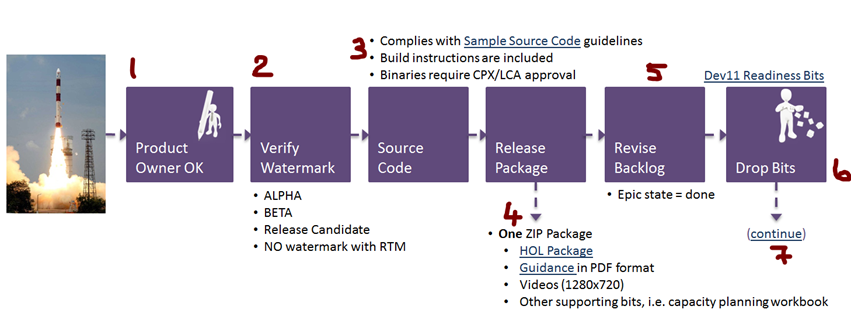Visual Studio ALM Rangers Transparency – Clarifying the processes: Release (Part 3)
We continue from Visual Studio ALM Rangers Transparency – Clarifying the processes: Projects (Part 1) and Visual Studio ALM Rangers Transparency – Clarifying the processes: Guidance (Part 2), which covered the high level project and guidance project views. In this post we will have a closer look at release process that each project lead goes through when preparing for BETA, Release Candidate (RC) or Release To Market (RTM).
Remember that the objective is to create a consolidated and easy to follow map of common ALM Ranger tasks as part of projects, in this case a Guidance project.
To cut a long story short, let us look at the steps that each ALM Rangers project team goes through when it is time to “click” the launch button and watch the hard work, the long nights and the endless commitment and passion is presented for release.
- Once the deliverables have gone through the numerous reviews, as discussed in previous posts, it is up to the product owner to approve the release to “ship”. In essence the project team goes into a deadlock until they get the following signal from the PO:
 … after which a wave of activity is triggered.
… after which a wave of activity is triggered. - All documentation receives a watermark to clearly indicate the relevant release status, ranging from ALPHA, BETA, RC to no watermark, which indicates that the artefacts are part of a major release, i.e. v1, v2, etc.
- Any source code that is included with tooling and guidance projects is validated to ensure that it adheres to the sample source guidelines and has gone through relevant code reviews and assessments. Binaries, such as tools, DLLs and installers have to go through additional assessments and approval checkpoints and are typically not included in ALPHA or BETA releases.
- All the bits and pieces needed to publish the release on Codeplex are packaged in one ZIP file. The bits and pieces include:
- Hands-on Lab (HOL) Package Zip
- All documentation in PDF format
- All videos in 1280x720 dimension format
- Other supporting bits, such as capacity planning workbooks
- Download release notes - The backlog is updated, whereby all completed and approved (point 1) Epics are switched to done and the remaining work, if any, is pruned for the next iteration.
- The last step, before the project leads enjoys a cool beer, is to drop the release package in the appropriate drop point, which triggers the publication on Codeplex by the support team.
- The team then continues with the next iteration, for example aiming for the release candidate, or switch to maintenance mode if they have just released the RTM.
Every ALM Rangers solution is geared at delivering value to the community and your candid feedback and success stories is an important catalyst and fuel for the next lifecycle of the project. :)
